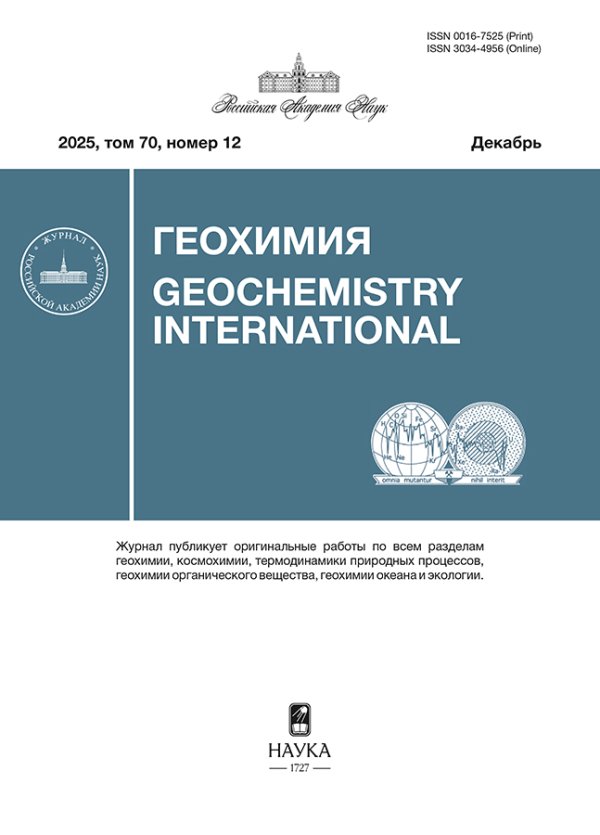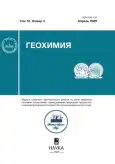РАСПРЕДЕЛЕНИЕ УГЛЕВОДОРОДОВ-БИОМАРКЕРОВ ПО ГЛУБИНЕ МОРСКИХ ОСАДКОВ В ОБЛАСТИ ЛИНЕЙНОЙ ДЕПРЕССИИ ЗАПАДНО-КАРСКОЙ СТУПЕНИ
- Авторы: Севастьянов В.С.1, Федулов В.С.1, Федулова В.Ю.1, Дженлода Р.X.1, Душенко Н.В.1, Воропаев С.А.1
-
Учреждения:
- Институт геохимии и аналитической химии им. В.И. Вернадского РАН
- Выпуск: Том 70, № 4 (2025)
- Страницы: 285-299
- Раздел: Статьи
- URL: https://journals.rcsi.science/0016-7525/article/view/304335
- DOI: https://doi.org/10.31857/S0016752525040028
- EDN: https://elibrary.ru/fxjldq
- ID: 304335
Цитировать
Аннотация
Важную информацию об осадочном органическом веществе (ОВ) представляют исследования молекулярного и углеводородного состава в морских донных отложениях. В данной работе было изучено распределение углеводородов и молекулярных маркеров по глубине осадочного чехла в области линейной депрессии Западно-Карской ступени. Для этого в ходе 89-го рейса НИС “Академик Мстислав Келдыш” были отобраны две колонки осадков: на станции 7444 и на фоновой станции 7441. Методом ГХ–МС анализа было измерено распределение н-алканов и установлены особенности изменения биомаркерных индексов по глубине осадка. Было показано, что высшая наземная растительность вносила доминирующий вклад в осадочное ОВ морских осадков на станциях 7444 и 7441. ОВ имело низкую зрелость, что показывают значения отношения Ts/(Ts+Tm). Согласно значениям индексов Г31–S/Г31–(S+R) и NAR, в исследуемом районе наблюдался небольшой постоянный привнос нефтяных углеводородов, при этом на фоновой станции 7441 он меньше. По характеру изменения индексов CPI25–33, TAR и NAR было предположено присутствие нефтяных углеводородов антропогенного происхождения в приповерхностных слоях 0–15 см осадка на фоновой станции 7441.
Ключевые слова
Об авторах
В. С. Севастьянов
Институт геохимии и аналитической химии им. В.И. Вернадского РАН
Email: fedulov.vs@yandex.ru
Россия, ул. Косыгина, 19, Москва, 119991
В. С. Федулов
Институт геохимии и аналитической химии им. В.И. Вернадского РАН
Email: fedulov.vs@yandex.ru
Россия, ул. Косыгина, 19, Москва, 119991
В. Ю. Федулова
Институт геохимии и аналитической химии им. В.И. Вернадского РАН
Email: fedulov.vs@yandex.ru
Россия, ул. Косыгина, 19, Москва, 119991
Р. X. Дженлода
Институт геохимии и аналитической химии им. В.И. Вернадского РАН
Email: fedulov.vs@yandex.ru
Россия, ул. Косыгина, 19, Москва, 119991
Н. В. Душенко
Институт геохимии и аналитической химии им. В.И. Вернадского РАН
Email: fedulov.vs@yandex.ru
Россия, ул. Косыгина, 19, Москва, 119991
С. А. Воропаев
Институт геохимии и аналитической химии им. В.И. Вернадского РАН
Автор, ответственный за переписку.
Email: fedulov.vs@yandex.ru
Россия, ул. Косыгина, 19, Москва, 119991
Список литературы
- Баранов Б.В., Амбросимов А.К., Мороз Е.А., Мутовкин А.Д., Сухих Е.А., Дозорова К.А. (2023). Позднечетвертичные контуритовые дрифты на шельфе Карского моря. ДАН. Науки о Земле. 511(2), 102–108.
- Галимов Э.М., Фрик М.Г. (1985). Изотопный метод диагностики нефтематеринских отложений. Геохимия. (10), 1474–1484.
- Галимов Э.М., Кодина Л.А., Степанец О.В., Коробейник Г.С. (2006). Биогеохимия Российской Арктики. Карское море. Результаты исследований по проекту SIRRO 1995–2003 гг. Геохимия. (11), 1139–1191.
- Galimov E.M., Kodina L.A., Stepanets O.V., Korobeinik G.S. (2006) Biogeo-chemistry of the Russian Arctic. Kara Sea: Research results under the SIRRO project, 1995–2003. Geochem. Int. 44(11), 1053–1104. https://doi.org/10.1134/S0016702906110012
- Гринько А.А., Гончаров И.В., Шахова Н.Е., Густафссон О., Обласов Н.В., Романкевич Е.А., Зарубин А.Г., Кашапов Р.С., Гершелис Е.В., Дударев О.В., Мазуров А.К., Семилетов И.П., Черных Д.В. (2020) Характерные особенности молекулярного состава органического вещества осадков моря Лаптевых в районах аномального выброса метана. Геология и геофизика. 61(4), 560–585.
- Петрова В.И., Батова Г.И., Куршева А.В., Литвиненко И.В. (2010) Геохимия органического вещества донных отложений центрально-арктических поднятий Северного Ледовитого океана. Геология и геофизика. 51(1), 113–125.
- Семенюк А.И. (2022). Актуальные проблемы добычи углеводородов на арктическом континентальном шельфе. Океанский менеджмент. 2(16), 27–30
- Aboul-Kassim T.A.T., Simoneit B.R.T. (1996). Lipid geochemistry of surficial sediments from the coastal environment of Egypt I. Aliphatic hydrocarbons – characterization and sources. Mar. Chem. 54(1–2), 135–158. https://doi.org/10.1016/0304-4203(95)00098-4
- Bai Y., Sicre M.-A., Ren J., Klein V., Jin H., Chen J. (2024) Latitudinal distribution of biomarkers across the western Arctic Ocean and the Bering Sea: an approach to assess sympagic and pelagic algal production. Biogeosciences. 21(3), 689–709. https://doi.org/10.5194/bg‑21-689-2024
- Blumenberg M., Lutz R., Schlomer S., Krüger M., Scheeder G., Berglar K., Heyde I., Weniger P. (2016) Hydrocarbons from near-surface sediments of the Barents Sea north of Svalbard – Indication of subsurface hydrocarbon generation? Mar. Pet. Geol. 76, 432–443. https://doi.org/10.1016/j.marpetgeo.2016.05.031
- Boucsein B., Knies J., Stein R. (2002) Organic matter deposition along the Kara and Laptev Seas continental margin (eastern Arctic Ocean) during last deglaciation and Holocene: evidence from organic-geochemical and petrographical data. Mar. Geol. 183(1–4), 67–87. https://doi.org/10.1016/S0025-3227(01)00249-3
- Bourbonniere R.A., Meyers P.A. (1996). Sedimentary geolipid records of historical changes in the watersheds and productivities of Lakes Ontario and Erie. Limnol. Oceanogr. 41(2), 352–359 https://doi.org/10.4319/lo.1996.41.2.0352
- Brune A., Frenzel P., Cypionka H (2000). Life at the oxic–anoxic interface: microbial activities and adaptations. FEMS Microbiol. Rev. 24(5), 691–710. https://doi.org/10.1016/s0168-6445(00)00054-1
- Dong L., Polyak L., Xiao X., Brachfeld S., Liu Y., Shi X., Fang X., Bai Y., Zhu A., Li C., Zhao S., Wu D., Wang C. (2022). A Eurasian Basin sedimentary record of glacial impact on the central Arctic Ocean during MIS1–4. Global Planet. Change. 219, Art.: 103993. https://doi.org/10.1016/j.gloplacha.2022.103993
- Gao Y., Tan J., Xia J., Wang Y.-P., Wang S., Han Y., He J., Song Z. (2021). Characteristics of organic matter and biomarkers in core sediments from the offshore area of Leizhou Peninsula, South China Sea. Front. Earth Sci. 9, Art.: 647062. https://doi.org/10.3389/feart.2021.647062
- Gebhardt A.C., Gaye-Haake B., Unger D., Lahajnar N., Ittekkot V. (2004) Recent particulate organic carbon and total suspended matter fluxes from the Ob and Yenisei Rivers into the Kara Sea (Siberia). Mar. Geol. 207(1–4), 225–245. https://doi.org/10.1016/j.margeo.2004.03.010
- Glukhovets D.I., Goldin Y.A. (2020). Surface desalinated layer distribution in the Kara Sea determined by shipboard and satellite data. Oceanologia. 62(3), 364–373. https://doi.org/10.1016/j.oceano.2020.04.002
- Goñi M.A., Yunker M.B., Macdonald R.W., Eglinton T.I. (2000) Distribution and sources of organic biomarkers in arctic sediments from the Mackenzie River and Beaufort Shelf. Mar. Chem. 71(1–2), 23–51. https://doi.org/10.1016/S0304-4203(00)00037-2
- González-Vila F.J., Polvillo O., Boski T., Moura D., de Andrés, J.R. (2003). Biomarker patterns in a time-resolved holocene/terminal Pleistocene sedimentary sequence from the Guadiana river estuarine area (SW Portugal/ Spain border). Org. Geochem. 34(12), 1601–1613. https://doi.org/10.1016/j.orggeochem.2003.08.006
- Hedges J.I., Keil R.G. (1995). Sedimentary organic matter preservation: an assessment and speculative synthesis. Mar. Chem. 49(2–3), 81–115. https://doi.org/10.1016/0304-4203(95)00008-F
- Horner T., Stein R., Fahl K., Birgel D. (2016) Post-glacial variability of sea ice cover, river run-off and biological production in the western Laptev Sea (Arctic Ocean) – A high resolution biomarker study. Quat. Sci. Rev. 143, 133–149. https://doi.org/10.1016/j.quascirev.2016.04.011
- Jeng W.-L., Lin S., Kao S.-J. (2003) Distribution of terrigenous lipids in marine sediments off northeastern Taiwan. Deep Sea Res., Part II. 50(6–7), 1179–1201. https://doi.org/10.1016/S0967-0645(03)00017-1
- Knoll A.H., Summons R.E., Waldbauer J.R., Zumberge J.E. (2007) The geological succession of primary producers in the oceans. In Evolution of Primary Producers in the Sea (Eds. Falkowski P.G., Knoll A.H.). Elsevier, 133–163. https://doi.org/10.1016/B978-012370518-1/50009-6
- Kolling H.M., Stein R., Fahl K., Sadatzki H., de Vernal A., Xiao X. (2020). Biomarker distributions in (sub)‐Arctic surface sediments and their potential for sea ice reconstructions. Geochem., Geophys., Geosyst. 21(10), Art.: e2019GC008629. https://doi.org/10.1029/2019GC008629
- Krajewska M., Lubecki L., Szymczak-Zyła M. (2023) Sources of sedimentary organic matter in Arctic fjords: Evidence from lipid molecular markers. Cont. Shelf Res. 264, Art.: 105053. https://doi.org/10.1016/j.csr.2023.105053
- Li Y., Pang L., Wang Z., Meng Q., Guan P., Xu X., Fang Y., Lu H., Ye J., Xie W. (2022). Geochemical characteristics and significance of organic matter in hydrate-bearing sediments from Shenhu area, South China Sea. Molecules. 27(8), Art.: 2533. https://doi.org/10.3390/molecules27082533
- Macías-Zamora J.V. (1996) Distribution of hydrocarbons in recent marine sediments off the coast of Baja California. Environ. Pollut. (Oxford, U.K.). 92(1), 45–53. https://doi.org/10.1016/0269-7491(95)00086-0
- Meredith W., Snape C.E., Carr A.D., Nytoft H.P., Love G.D. (2008) The occurrence of unusual hopenes in hydropyrolysates generated from severely biodegraded oil seep asphaltenes. Org. Geochem. 39(8), 1243–1248. https://doi.org/10.1016/j.orggeochem.2008
- Meyers P.A. (2003). Applications of organic geochemistry to paleolimnological reconstructions: a summary of examples from the Laurentian Great Lakes. Org. Geochem. 34(2), 261–289. https://doi.org/10.1016/s0146-6380(02)00168-7
- Meyers P.A., Ishiwatari R. (1993). Lacustrine organic geochemistry – an overview of indicators of organic matter sources and diagenesis in lake sediments. Org. Geochem. 20(7), 867–900. https://doi.org/10.1016/0146-6380(93)90100-P
- Mille G., Asia L., Guiliano M., Malleret L., Doumenq P. (2007) Hydrocarbons in coastal sediments from the Mediterranean Sea (Gulf of Fos area, France). Mar. Pollut. Bull. 54(5), 566–575. https://doi.org/10.1016/j.marpolbul.2006.12.009
- Moldowan J.M., Sundararaman P., Schoell M. (1986) Sensitivity of biomarker properties to depositional environment and/or source input in the Lower Toarcian of SW-Germany. Org. Geochem. 10(4–6), 915–926. https://doi.org/10.1016/S0146-6380(86)80029-8
- Morgunova I.P., Petrova V.I., Litvinenko I.V., Kursheva A.V., Batova G.., Renaud P.E., Granovitch A.I. (2019). Hydrocarbon molecular markers in the Holocene bottom sediments of the Barents Sea as indicators of natural and anthropogenic impacts. Mar. Pollut. Bull. 149, Art.: 110587. https://doi.org/10.1016/j.marpolbul.2019.110587
- Nabbefeld B., Grice K., Schimmelmann A., Summons R.E., Troitzsch U., Twitchett R.J. (2010) A comparison of thermal maturity parameters between freely extracted hydrocarbons (Bitumen I) and a second extract (Bitumen II) from within the kerogen matrix of Permian and Triassic sedimentary rocks. Org. Geochem. 41(2), 78–87. https://doi.org/10.1016/j.orggeochem.2009.08.004
- Nemirovskaya I.A., Khramtsova A.V. (2022). Anthropogenic and natural hydrocarbons in water and sediments of the Kara Sea. Mar. Pollut. Bull. 185, Art.: 114229. https://doi.org/10.1016/j.marpolbul.2022.114229
- Ogbesejana A.B., Liu B., Gao S., Akinyemi S.A., Bello O.M., Song Y. (2023). Applying biomarkers as paleoenvironmental indicators to reveal the organic matter enrichment of shale during deep energy exploration: a review. RSC Adv. 13(36), 25635–25659. https://doi.org/10.1039/d3ra04435a
- Peters K.E., Walters C.C., Moldowan J.M. (2005). The biomarker guide II. Biomarkers and isotopes in petroleum systems and earth history, 2nd ed., Vol 2. Cambridge: Cambridge University Press, 701 p.
- Seifert W.K., Moldowan J.M. (1980). The effect of thermal stress on sourcerock quality as measured by hopane stereochemistry. Phys. Chem. Earth. 12, 229–237. https://doi.org/10.1016/0079-1946(79)90107-1
- Silliman J.E., Schelske C.L. (2003). Saturated hydrocarbons in the sediments of lake apopka, Florida. Org. Geochem. 34(2), 253–260. https://doi.org/10.1016/s0146-6380(02)00169-9
- Tesi T., Miserocchi S., Goñi M.A., Langone L., Boldrin A., Turchetto M. (2007). Organic matter origin and distribution in suspended particulate materials and surficial sediments from the western Adriatic Sea (Italy). Estuarine, Coastal Shelf Sci. 73(3–4), 431–446. https://doi.org/10.1016/j.ecss.2007.02.008
- Venkatesan M.I., Kaplan I.R. (1982). Distribution and transport of hydrocarbons in surface sediments of the alaskan outer continental shelf. Geochim. Cosmochim. Acta. 46(11), 2135–2149. https://doi.org/10.1016/0016-7037(82)90190-9
- Wenger L.M., Davis C.L., Isaksen G.H. (2002). Multiple controls on petroleum biodegradation and impact on oil quality. SPE Reserv. Eval. Eng. 5(5), 375–383. https://doi.org/10.2118/80168-pa
- Xiao X., Fahl K., Stein R. (2013). Biomarker distributions in surface sediments from the Kara and Laptev seas (Arctic Ocean): indicators for organic-carbon sources and sea-ice coverage. Quat. Sci. Rev. 79, 40–52. https://doi.org/10.1016/j.quascirev.2012.11.028
- Xu L., Wang J. (2022). Distribution characteristics of long-chain branched alkanes with quaternary carbon atoms in the carboniferous shales of the Wuwei Basin, China. Front. Earth Sci. 9, Art.: 819732. https://doi.org/10.3389/feart.2021.819732
- Yunker M.B., Macdonald R.W., Veltkamp D.J., Cretney W.J. (1995) Terrestrial and marine biomarkers in a seasonally ice-covered Arctic estuary – integration of multivariate and biomarker approaches. Mar. Chem. 49(1), 1–50. https://doi.org/10.1016/0304-4203(94)00057-K
- Yunker M.B., Macdonald R.W., Snowdon L.R., Fowler B.R. (2011) Alkane and PAH biomarkers as tracers of terrigenous organic carbon in Arctic Ocean sediments. Org. Geochem. 42(9), 1109–1146. https://doi.org/10.1016/j.orggeochem.2011.06.007
- Zaghden H., Tedetti M., Sayadi S., Serbaji M.M., Elleuch B., Saliot A. (2017). Origin and distribution of hydrocarbons and organic matter in the surficial sediments of the Sfax-Kerkennah channel (Tunisia, Southern Mediterranean Sea). Mar. Pollut. Bull. 117(1–2), 414–428. https://doi.org/10.1016/j.marpolbul.2017.02.007
- Zegouagh Y., Derenne S., Largeau C., Saliot A. (1996) Organic matter sources and early diagenetic alterations in Arctic surface sediments (Lena River delta and Laptev Sea, Eastern Siberia)-I. Analysis of the carboxylic acids released via sequential treatments. Org. Geochem. 24(8–9), 841–857. https://doi.org/10.1016/S0146-6380(96)00075-7
Дополнительные файлы










